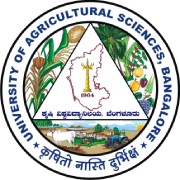
| AICRP Scheme/Unit : All India Coordinated Research Project on Rice | ||||||
| Location : V.C. Farm, Mandya | ||||||
| Year of Start : 1969 | ||||||
| Mandates :
ü To identify, de-lineate and characterize the Rice growing situations in southern Karnataka. ü To develop high yielding Rice varieties / hybrids and their production and protection technologies. ü To coordinate the evaluation and screening of rice genotypes for breeding, agronomical, soil science, pathological and entomological aspects. ü To take up Nucleus and Breeders’ seed production of identified rice varieties as per state and national indent. ü Monitoring and forewarning the pest and disease occurrence and advisory services. ü Collection, characterization and utilization of local rice germplasm and their conservation. |
||||||
| Research Programmes :
Crop Improvement : 1.Development of rice varieties with enhanced resistance and/or tolerance to biotic and abiotic stresses through Marker Assisted Back cross Breeding 2.Evaluation of rice geno types nominated through All India Coordinated Rice Varietal Trials 3.Characterization, purification and improvement of traditional rice variety of Karnataka “Rajamudi” 4.Identification of Rice genotypes for constitution of elite breeding panel 5.Genomic selection assisted prediction of heterosis using selected indica accessions from 3K panel of rice (Oryza sativa L.) 6.Haplotype based GWAS for weed competitive traits in 3K panel of rice (Oryza sativa L.)
Crop production Agronomy : 1.Nutrient response studies in selected advance rice varieties for higher productivity 2.Development of resource conservation technologies for efficient use of seed, nutrients, soil, water and labourer in rice production 3.Development of site specific integrated plant nutrient management system (IPNS) for system productivity and quality in different rice establishment 4.Integrated weed and nutrient managements in direct seeded rice under rice-based cropping system 5.Integrated Pest Management (specific to weed) in rice crop under farmers’ fields 6.Studies on yield maximization in rice production 7.Studies on rice based crop diversification for sustainability of the system 8.Analysis of long-term meteorological data (Temperature and Rainfall) for identifying the reasons for yield reduction in rice Entomology : 1.Screening of rice germplasm / landraces against BPH under glass house and yellow stem borer under field condition 2.Evaluation of entomopathogens against rice ear head bug (Leptocorisa acuta) 3.Integrated Pest Management in rice crop under farmers’ fields 4.Evaluation of bio efficacy of new insecticide molecules against insect pests of rice 5.To under take pest and production oriented survey Pathology : 1.Screening for Leaf Blast resistance under Uniform Blast Nursery: NSN-1, NSN-2, NHSN, BL, DBT-1, DBT-2, Hybrid Rice 2.Screening for Neck Blast Resistance: NSN-1, NSN-2, NHSN, BL, DBT-1, DBT-2 and Hybrid Rice lines 3.Screening for Sheath Blight resistance: NSN-1, NSN-2, NHSN, BL, DBT-1, DBT-2 and Hybrid Rice lines 4.Field Monitoring of Virulence: Pyricularia oryzae 5.Disease Observation Nursery on trap crop 6.Evaluation of Fungicides for Location Specific Diseases 7.Integrated Pest Management (Special) 8.Special trial on yield loss assessment due to major rice diseases 9.To undertake production oriented survey Soil Science : 1.Long term soil fertility management in rice –based cropping system (Rice – Cowpea) 2.Management of sodic soils by using nano zinc formulations 3.Evaluation of organic fertilizers and natural farming practices for enhancing the productivity and soil heath. |
||||||
| Research Accomplishments :
(Varieties released /Technologies developed / Patents developed/ Commercialized etc…) Varieties released 1.Crop Improvement KMP-175 (Daksha) It is a short duration variety with 115 to 120 days duration. It grows up to 100-110cm with potential grain yield of 16-18 q/acre and 18-20 q/acre of fodder yield. This variety is suitable for cultivation in kharif (upto end of July) and summer (upto end of January) seasons and also suitable for direct sowing in aerobic method. 2.KMP-101 (Thanu) This variety is developed by crossing Mandya Vijaya and Bilimukthi varieties. It has fine grains similar to mahsuri paddy variety. This is medium duration variety that can be harvested in 130 to 135 days after sowing. This variety is suitable for taking up the nursery until second week of July. It has attracting colour with medium height and high grain and fodder yield. The grain yield potential of this variety is 18-20 q/acre. 3.KMP-220 (Mandya Jyothi) This is a medium duration variety that can be harvested in 125 to 130 days after sowing. This variety can be sown during July 1st to 2nd week and transplanted within 1st week of August in southern dry zone of Karnataka (Zone-6). The grains of this variety are long bold with red kernel and are highly similar to the grains of Jyothi rice variety. Compared to Jyothi rice variety, KMP-220 is moderately tolerant to blast disease and is taller than Jyothi variety and hence gives higher straw and grain yield. Hence, KMP-220 can be grown instead of blast susceptible Jyothi variety. The grain yield potential of this variety is 24-26 q/acre. 4.KMP-225 This is an early duration variety that can be harvested in 120 to 125 days after sowing. This variety can be sown during July 3rd to 4th week and transplanted by the end of August in southern dry zone of Karnataka (Zone-6). The grains of this variety are long bold and are highly similar to the grains of IR-64 rice variety. Compared to IR-64 rice variety, KMP-225 is moderately tolerant to leaf and neck blast disease. Hence, KMP-225 can be grown instead of blast susceptible IR-64 rice variety. The grain yield potential of this variety is 24-26 q/acre. 5. KMP-105 (Raksha) This is an early duration variety that can be harvested in 110 to 115 days after sowing with medium height. This variety is suitable for cultivation in kharif (upto end of August) and summer (upto first week of February) seasons and tolerant to blast disease. Rice of this variety is fine and good quality. This variety is also suitable for low water condition. The grain yield potential of this variety is 16-18 q/acre. 6.Mukthi (CTH-1) This variety has the long bold grain with red kernel and it can be harvested in 125 to 130 days after sowing. This variety is suitable for sowing till the end of august and transplanted up to end of September. The grain yield potential of this variety is 12-14 q/acre. 7.Bilimukthi (CTH-3) This variety is reselected from mukthi and it can be harvested in 120 to 125 days after sowing. Compared to mukthi it is short and it has the long bold grains with white kernel. This variety is suitable for sowing till the end of August and transplanted up to end of September. The grain yield potential of this variety is 14-16 q/acre. 8. Rasi This variety is popularly known as IET-1444 at national level and Bharani at regional level. It can be harvested in 120 to 125 days after sowing. Rasi variety is drought tolerant and hence it can be cultivated in low water situation. The grains of this variety is medium bold and yields 16-18q of grain per acre.
Varieties identified and endorsed : 1.BR-2655 This variety can be harvested in 140 to 145 days after sowing. This variety is suitable for sowing up to end of June. As compared to Jaya, this variety grows taller and non lodging. It gives high yield after milling and tolerant to blast disease. The grain yield potential of this variety is 24-26 q/acre.It is a long duration variety with 140 to 145 days duration. It has the wider adaptability and suitable for making flaked rice. The grain yield potential of this variety is 22-24 q/acre. 2. MTU-1001 This variety popularly known as Vijetha can be harvested in 130 to 135 days after sowing. This variety is suitable for taking up the nursery till second week of July. The plant is medium height with resistance to brown plant hopper. The grains of this variety are bold with an yield potential of 18-20q/acre. 3. MTU-1010 This variety can be harvested in 120 to 125 days after sowing. The grains of this variety are long slender. The variety is suitable for cultivation in limited water situation with potential yield of 18-20q of grain per acre. 4. RNR-15048 This is an early duration variety that can be harvested in 120 to 125 days after sowing. This variety can be sown during July 3rd to 4th week and transplanted by the end of August in southern dry zone of Karnataka (Zone-6). The grains of this variety are very fine with good cooking quality. This variety has wide adaptability with good market demand. The grain yield potential of this variety is 24-26 q/acre. 5. Gangavathi Sona (IET-20594) It is a medium duration variety that matures in 130 to 135 days. The grains of this variety are fine with good quality. The grain yield potential of this variety is 18-20 q/acre. 6. IR-30864 This variety can be harvested in 130 to 135 days after sowing. This variety is suitable for taken up sowing in second week of july. This variety has good tolerance to salinity and alkalinity. Hence this variety can be cultivated in saline alkaline soils. The grains of this variety are medium slender with good head rice recovery. The grain yield potential of this variety is 18-20 q/acre. 7. JGL-1798 It is a medium duration variety with 130 to 135 days duration. The grains of this variety are fine with good cooking quality. The grain yield potential of this variety is 20-22 q/acre. 8. IR-64 This variety is developed by IRRI, Philiphines. It can be harvested in 125 to 130 days after sowing. This variety is suitable for sowing in second week of july. The grains of this variety are medium bold and long. Sufficient care has to be taken as this variety is susceptible to blast disease. The grain yield potential of this variety is 24-26 q/acre.
Technologies developed : 1.Use of SSR markers to determine the genetic purity of seeds of rice varieties 2.Use of SSR markers to determine the genetic purity of Maize hybrids and seeds of their parental lines 3.PCR based detection of seed borne pathogens in the seeds of Maize 4. In transplanted rice, Bensulfuron methyl (0.6 %) + Pretilachlor (6.6%G) at 10 kg /ha as pre-emergence application was recommended for effective weed management 5. Application of Bispyribac sodium (10% SC) @ 250 ml/ha at 12 to 15 DAP as post emergence weed management in transplanted rice was recommended 6.The recommended fertilizer requirement for hybrid rice production was modified as 120 N:60P2O5:60K2O kg/ha for sustainable higher production in Cauvery command and other irrigated maidan areas of Karnataka 7. In SRI method, planting of 8 to 12days aged rice seedling along with adoption of inter cultivation with cono-weeder for four times during vegetative growth stage was found effective in increasing grain yield 8. In aerobic rice, the recommended nitrogen dose of 100 and 125 kg per hectare, for kharif and summer, respectively followed by pre-emergence application herbicide or inter crop of Rice : dhaincha (1:1) green manure + one hand weeding or post emergence application of 2,4-D- Na salt @ 1.0 kg ai/ha at 35 DAS was found to be optimum 9. In transplanted paddy seed rate was standardized based on seed size and recalculated as 65, 56 and 36 kg/ hectare for bold, medium bold and fine grain seeds, respectively over existing blanket recommendation of seed rate at 62 kg/ hectare for irrespective of seed size 10. Weed management in wet and dry rice nurseries by using pre-emergence herbicides viz., Butachlor 50 EC @ 2500ml/ha or Pyrazosulfuron ethyl 10WP @ 250 g /ha or Bensulfuron methyl 60 g + Pretilachlor 600g a.i./ha (66G) @ 10.0 kg/ha or Pretilachlor 50 EC +Safenor @ 600 ml/ha at 3DAS was recommended to effective control of weeds 11. Machine transplanting was recommended to increase the paddy yield by 15-20 % over farmers practice of manual transplanting, besides saving the transplanting cost by Rs. 2000/ha 12. Agro-techniques were standardization for System of Rice Intensification (SRI), Mechanized System of Rice Intensification (MSRI) and nursery techniques for MSRI 13. The Alternate Wetting and Drying (AWD) irrigation (5cm depth for once in 4 to 5 days) in transplanted paddy was recommended up to panicle initiation for higher paddy grain yield (5.74 t/ha) and water use efficiency (4.92 kg/ha-mm) than the flooding throughout crop growth with 3 ± 2cm standing water (5.37 t/ha and 2.90 kg//ha-mm, respectively) 14. In drum seeded rice, application of Bensulfuron methyl (0.6% G) @ 60 g + Pretilachlor (6%G) @ 600 g ai/ha combi-product (10 kg/ha) at 5th day of sowingas pre-emergence weed control was recommended for obtain higher paddy grain yield and to effective management of complex weed flora 15. Application of post-emergence herbicide Bispyribac sodium (10% SC)@ 8 ml / 3 guntas in 15 lit of water. at 10 to 12 DAS in paddy dry and wet nursery was recommended to obtain higher weed control efficiency (95.1 to 99.5%), and lower weed control cost as compared to farmers method of weeding 16. Soil application of microbial consortium (Azospirillum + Bacillus + Pseudomonas + Trichoderma) @ 5.0 kg/ha at 8 to 10 days after transplanting as plant growth promoting rhizo-bacteria has been recommended for higher paddy grain yield and also to fix non-symbiotic atmospheric nitrogen in soil 17. The rice-pulse cropping system, rice followed by succeeding crop of cowpea / field bean during rabi/summer season was recommended for sustainability of rice based cropping system in the Cauvery command area of Karnataka 18. Management of sheath blight of paddy : spray thifluzamide 24SC@ 1ml/lt as soon as the symptoms are seen and if necessary at 15 days interval to manage sheath blight of paddy 19. Management of sheath blight and neck blast disease of paddy: sprayTrifloxystrobin 25 % +Tebuconazole 50% ( nativo75WP) (0.4g/l) as soon as the symptoms are seen and compulsorily at % panicle emergence stage for the management of neck blast of disease 20. Management of sheath blight of paddy: Spray carbendazim 25% + flusilazole 12.5% SE (NS) @ 960 ml/ha as soon as the as the symptoms are seen and if necessary at 15 days interval to manage sheath blight disease of paddy 21. Management of sheath blight of paddy: management of sheath blight of paddy using pseudomonas fluoroscensas the seedling dip for 30 minutes @ 10 ml. per liter of water prior to transplanting and 2.50 lit per ha as foliar application at 45 and 55 days after transplanting 22. Management of rice blast disease in nursery by seed treatment : Seed treatment method for the management of blast and brown spot diseases in paddy nursery by soaking 25 kg seeds in 25 litres fungicide solution (Carbendazim 50 WP 4g/l or tricyclazole 75WP 3g/l or carbendazim 25% + mancozeb 50%WS 4g/l) for 12h and including for 24-48h in wet gunny bag till seeds just start sprouting before sowing 23. Seed treatment : Management of seeds borne disease through seed treatment Tebuconazole 50% + Trifloxystrobin 25 % w/w WG (75WG) @ 0.5g/kg (fungicide suspension prepared in 1 litre of water ) by following dry or wet method for the effective management of blast and brown spot disease in paddy nursery 24. The bioagent Pseudomonas fluoroscens was recommended for seedling dip @10ml/l for 30min at the time of transplanting and as foliar application @ 5ml/l (2.5l/ha) at 45 & 55 days after transplanting for the management of sheath blight of paddy 25. Management of blast and brown spot disease in paddy nursery: Seed treatment with Tebuconazole 50%+Trifloxystrobin 25% (75WG) @ 0.5g/kg (1litre fungicide suspension) or 0.5g/l following dry or wet method for the effective 26. Management of sheath blight and neck blast disease of rice: spray Tricyclazole 45% + Hexaconazole 10% WG (Impression) @ 1g/l as soon as the symptoms are noticed or at 5% panicle emergence to manage neck blast 27. Management brown spot disease in rice : Spraying of hexaconozole 5 SC @ 2ml / liter as soon as the symptoms are seen above ETL) and necessary at 15 days interval for the 28. Leaf blast of rice management : Spraying of Tricyclazole 75 WP + Sea weed extract LBD (0.4g+2ml/l) as soon as the leaf blast symptoms are seen and if necessary at 15 days interval 29. Management of bacterial blight in paddy : Seed treatment with 0.5 gm streptocycline + copper oxychloride 1 g/l of water (soak whole seeds overnight) along with spraying 0.2 gm streptocycline + 1gm of copper oxychloride per litre of water as soon as the disease is observed will reduce 30. Management of rice yellow stem borer, Scirpophaga incertulas (Walker) by using chlorantraniliprole 0.4% GR 31. Management of rice leaf folder (Cnaphalocosis medinalis) by spraying of Indoxacarb 14.5% SC @ 0.5ml/ lit 32. Spraying Flubendiamide 480 SC@ 0.1 ml/lit or Flubendiamide 20 WDG @ 0.2 gm/lit for the management of stem borer (Scirpophaga incertulas) and leaf folder (Cnaphalocrosis medinalis) of paddy 33. Spraying of buprofezin 25% SC @ 1.4 ml/lit for the management ofbrown planthopper, Nilapatvata lugens (Stal) 34. Management of rice brown planthopper (Nilaparvta lugens) by using Triflumezopyrim 10% SC @ 0.40 ml/lit 35. Management of rice earhead bug (Leptocorisa acuta) by using Fipronil 5% SC @ 2 ml/lit or Thiamethoxam 25% WG @ 0.3 gm/lit 36. In transplanted rice, split application of potassium as at 50%basaland 50% top dress at panicle initiation stage for higher efficiency 37. Application of 20 kg/hasulphur as nutrient in rice at planting for recommended 38. Application of 40 kg/ha Zinc sulphate for alkali soilwas recommended 39. Boulder and tile drainage was recommended for management of irrigated lowland rice alkali soil 40. Use of phosphorus solubilizing bacteria @ 800g ac-1was recommended to utilize fixed phosphorus from paddy soils 41. Use of sulphitation press mud @15 t ha-1as an amendment for rice alkali soils |
||||||
| Awards / Recognitions
· Received Best AICRP- Agronomy Discipline Center Award for the year 2011-12 from ICAR – Indian Institute Rice Research, Hyderabad · Golden Jubilee Best AICRP Soil Science Center Award for the year 2014 from ICAR – Indian Institute Rice Research, Hyderabad · Dr. R. Krishnamurthyhas recognized as the Best Rice Soil Science Co-operator in the 50th Annual Rice Research Group meeting held at ICAR-IIRR, Hyderabad during 11th – 15th April, 2015 |
||||||
| Facilities Available :
Crop Improvement : · Marker Assisted Selection Laboratory · Genetic purity and seed health testing laboratory · Vacuum emasculator · Polyhouse Crop Production : Agronomy · Adequate lowland irrigated field with protective irrigation and all field facilities available for taking up field experiments Pathology . Protected field facility for screening of rice diseases Entomology · Glass house facility for screening of rice germplasms against BPH · Rearing of brown plant hoppers (Nilaparvata lugens) in wooden cages Soil Science · Soil Samples- Analysis Soil pH, EC, OC, Phosphorus and Potassium · Plant samples- Analysis plant P and K
|
||||||
| Other Activities :
· Providing advisory service to visiting farmers and over telephone · Conducting training programs on improved varieties and production practices of rice · Conducting Front Line Demonstrations of new rice varieties and technologies · Participation in diagnostic field visits of problematic rice plots
|
||||||
| Externally Funded Projects in Operation: | ||||||
| No. | Project Title | Principal Investigator | Funding agency | Year of Start | Year of Completion | Significant Outcome |
| 1 | Mainstreaming rice landraces diversity in varietal development through genome wide association studies: A model for large-scale utilization of gene bank collections of rice | Dr. C. A. Deepak | DBT, New Delhi | 2020 | 2025 | Identification of Blast resistant and BPH tolerant rice genotypes
|
| 2. | Evaluation of Agronomic Bio- efficacy of RhizoMyx Eco Gr formulation in paddy | Dr. G.R. Denesh | Novozymes
Pvt. Ltd. |
2023 | 2024 | — |
| 3. | Testing of bio-efficacy of Topramezone 336 g/l SC against weed flora of maize and its residual effect on succeeding crop | Dr. G.R. Denesh | Rainbow Agrosciences Pvt. Ltd. | 2023 | 2024 | — |
| 4 | Evaluation of effect of trackon gold application on qualitative and quantitative parameters, nutrient uptake, soil physicochemical, growth yield of rice, maize an pigeon pea | Dr. H. R.
Savitha |
Sulphur Mill Private Limited, Bombay | 2021 | 2023 | — |
Staff Profile
Scientific staff :

Dr. Denesh, G. R.
Designation : Professor and Scheme Head
Academic Qualification : M. Sc. (Agri.), Ph. D, PGDHRM
Area of Specialization: Crop Growth Modeling, Weed Management, Irrigation & Fertilizer Management
Date of joining duty at UAS, Bangalore : 18.08.2009
Date of Joining Scheme /Unit : 23.03.2018
grdeneshrice@uasbangalore.edu.in
grdenesh@rediffmail.com
08232-277923
+91-9448980134

Dr. C. A. Deepak
Designation Junior Rice Breeder
Academic Qualification M. Sc. (Agri.), Ph. D.
Area of Specialization Genetics and Plant Breeding
Date of joining duty at UAS, Bangalore : 27.09.2013
Date of Joining Scheme /Unit : 27.09.2013
deepuca@googlemail.com
08232 – 277923
9945757507

Dr. V. B. Sanath Kumar
Designation : Professor and Rice Pathologist
Academic Qualification : M. Sc. (Agri), Ph. D
Area of Specialization : Fungal Pathology
Date of joining duty at UAS, Bangalore :15-02-2006
Date of Joining Scheme /Unit :19-09-2022
sanath.kumar7@gmail.com
9449113311

Dr. M.S. Kitturmath
Designation : Entomologist
Academic Qualification : M.Sc. (Ag), Ph.D. (Agricultural Entomology)
Area of Specialization : Rice entomology, Insecticide toxicology
Date of joining duty at UAS, Bangalore : 27.02.2018
Date of Joining Scheme /Unit : 27.03.2018
e-mail: kitturmathms@uasbangalore.edu.in
muttu78@rediffmail.com
Mobile No: +91-9740301274

Dr. Savitha, H.R.
Designation : Junior Soil Scientist
Academic Qualification : Ph.D. in Soil Science
Area of Specialization : Soil Science (Soil Fertility)
Date of joining duty at UAS, Bangalore : 28.03.2018
Date of Joining Scheme /Unit : 28.10.2020
Savitha2094@gmail.com
9964072409
Supporting staff:

L. Manjunatha
Designation : Senior Field Assistant
Academic Qualification : SSLC
Date of joining duty at UAS, Bangalore : 22.11.1990
Date of Joining Scheme/Unit : 01.04.2001
9900466192

Krishna, P.K
Designation : Field Assistant
Academic Qualification : SSLC
Date of joining duty at UAS, Bangalore : 01.07.1998
Date of Joining Scheme/Unit : 04.05.2020
9900622196

Ramesh. A.
Designation : Field Assistant
Academic Qualification : PUC (Arts)
Date of joining duty at UAS, Bangalore :06.09.2019
Date of Joining Scheme/Unit :13.07.2021
Mobile No: +91-9035599498

Jayarama C.N
Designation : Sr. Field Assistant
Academic Qualification : SSLC
Date of joining duty at UAS, Bangalore :03.02.2004
Date of Joining Scheme/Unit : 16.07.2020
9164570031
-
- Page Visitors Count:
- Last Updated: March 19, 2025
- Site Statistics




